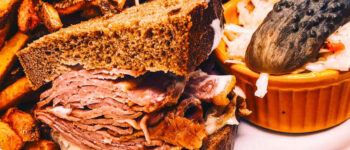Espresso and hot water sounds like a simple recipe. In reality, though, both the quality of the ingredients, and the way they’re combined, will determine whether an Americano is properly prepared.
The Espresso
To make a great Americano, you must start with great espresso.
You probably know that there’s no such thing as “espresso beans.” Espresso is made from the same coffee beans that are used to make standard drip coffee. The differences are created by the roast, the blend and the brewing process.
Let’s talk process first.
Drip coffee is brewed just as its name describes, with hot water slowly dripped through coffee grounds. When espresso is made, though, a small amount of almost-boiling water is forced through the finely-ground coffee at high pressure. The end result is a thicker, stronger, dark brown coffee which is produced in a matter of seconds, not minutes.
Now, let’s talk roast.
Espresso is normally made from dark-roasted beans, because they create a fuller body and less acidity. They also create - and this is important - a thicker crema at the top.
That’s because of the oil that builds up on the surface of dark roast beans; it’s forced out of the beans by the hot water and steam, forming an oily, rich, creamy layer of foam that rises to the top of a well-made espresso.
Finally, the blend. Most coffee drinkers are aware that Arabica beans produce coffee that’s cleaner, sweeter and softer, with good acidity. Robusta beans aren‘t usually used to make high-quality coffee, because they produce harsher coffee with more bitterness and a lot more caffeine.
See more : Kentucky Legend’s Ultimate Ham Thawing Guide
The exception is for espresso. Many espresso blends, particularly in America, combine Arabica beans with a small amount of Robusta beans in order to give the coffee more body and more caffeine.
Mixing them isn’t required; lots of people swear by espresso made from 100% Arabica beans. But Robusta beans are often used, and many aficionados who love a good espresso swear by the powerful product of the Arabica/Robusta combination.
Most important of all is equipment and technique.
The right espresso machine, the proper amount and distribution of grounds, and the right temperature and amount of water used to extract the brew all play huge roles in creating barista-quality espresso. To get to that point requires experience - or finding the right coffee shop.
The Water
Needless to say, clean, fresh water is important when making coffee.
It’s even more important when making an Americano, because the drink is prepared by the pour-over process; the two liquids are layered, not combined. That ensures a smoother drink and preserves the integrity of the crema.
How hot should the water be? Opinions vary.
Most experts shoot for 185°F, but some believe that water heated to 200°F makes a better Americano coffee. (Of course, you use cold water to make an iced Americano.) There’s also a school of thought that the water has to come directly from the espresso machine, but that’s purely optional.
Making the Americano
We’ve already spoiled the surprise: a Caffè Americano isn’t made by mixing espresso and hot water. The two are layered. But which goes first? The answer isn’t clear-cut.
See more : How to Cut After Bulking (Everything You Need to Know)
Some people believe that hot water should be poured over the espresso, saying that method best preserves the espresso’s body and crema. (That’s the way Starbucks does it.)
Others insist that the proper way to make an Americano is by pouring the espresso over the water. They claim that method creates more crema and avoids scalding the espresso if the water’s too hot.
Water added to espresso is known in many circles as an “original Americano.” Doing it the opposite way produces what’s called a “Long Black,” a name coined by Australians when Italians introduced the drink Down Under.
But which is “right?” We’re not going to get into the middle of that argument; an Americano is great both ways.
The one remaining question is how much espresso and how much water should be used.
The traditional way to make a Caffè Americano is with 1-2 shots of espresso, and up to six ounces of hot water. Of course, there’s no law against adding another espresso shot (or two), and many people do.
For a potent Americano with extremely rich flavor, use strong espresso. If you want a less potent version, order a lungo (“long” in Italian); the ground espresso is left to extract for twice as long. That produces as much liquid as a normal double shot, but it will be weaker and may be more bitter.
A better choice would be a caffè crema, a drink that’s popular in Northern Italy. The extraction process is also longer than normal, but coarser-ground espresso is used to reduce the bitterness.
Obviously, a double shot of espresso will have twice as much caffeine content as an Americano made with just one shot of espresso. Either way, this coffee drink is still comparable to a black coffee in that regard: 60-120 milligrams of caffeine for the Americano, about 95mg of caffeine for a cup of drip coffee.
Want more caffeine? Top your Americano with a shot of black coffee. That’s called a red eye.
Nigel Gildon editor:Nigel Gildon is the editor of Chef Wayne’s Big Mamou: Chef Wayne’s Big Mamou. He has worked in the publishing industry for many years and has a passion for helping new authors get their work into the hands of readers. 63 Liberty Street * Springfield, MA 01003




